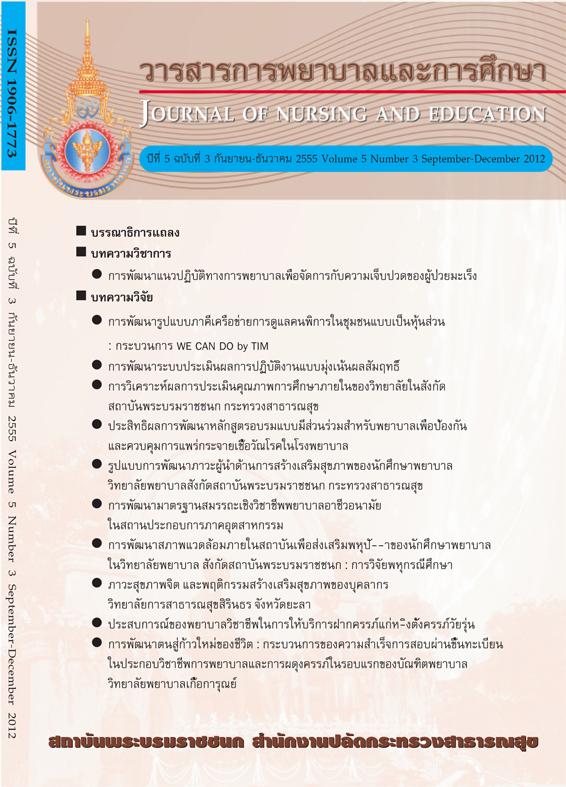ประสิทธิผลการพัฒนาหลักสูตรอบรมแบบมีส่วนร่วมสำหรับพยาบาลเพื่อป้องกัน และควบคุมการแพร่กระจายเชื้อวัณโรคในโรงพยาบาล
คำสำคัญ:
The effectiveness Participatory Curriculum Development, The tuberculosis prevention and control in hospitalบทคัดย่อ
บทคัดย่อ
การวิจัยครั้งนี้มีวัตถุประสงค์ เพื่อพัฒนาหลักสูตรอบรมพยาบาลเพื่อการป้องกันและควบคุม การแพร่กระจายเชื้อวัณโรคในโรงพยาบาล และเปรียบเทียบการปฏิบัติงานด้านการป้องกันและควบคุม การแพร่กระจายเชื้อวัณโรคในโรงพยาบาลของบุคลากรก่อนและหลังเข้ารับการอบรมโดยใช้รูปแบบ การวิจัยและพัฒนา ใช้ระเบียบวิธีการวิจัยเชิงปริมาณและคุณภาพ ประชากรที่ใช้ในการวิจัยเป็นพยาบาล วิชาชีพที่ปฏิบัติงานด้านการควบคุมและป้องกันการแพร่กระจายเชื้อในโรงพยาบาลทั่วประเทศไทย จำนวน 1,368 คน คำนวณขนาดของกลุ่มตัวอย่างโดยใช้สูตรทาโรยามาเน่ ได้ขนาดกลุ่มตัวอย่าง 310 คน เพื่อให้เกิด ความเข้มแข็ง ผู้วิจัยเพิ่มขนาดกลุ่มตัวอย่างเป็น 320 คน สุ่มโรงพยาบาลตามภาค แบ่งเป็น ภาคตะวันออกเฉียงเหนือ ภาคเหนือ ภาคใต้ ภาคกลาง และภาคตะวันออก โดยการสุ่มตัวอย่างอย่างง่าย ตามสัดส่วนจำนวนโรงพยาบาล หลังจากนั้นสุ่มกลุ่มตัวอย่างที่เป็นพยาบาลที่ปฏิบัติงานด้านการป้องกันและ ควบคุมการแพร่กระจายเชื้อวัณโรคในโรงพยาบาลตามสัดส่วนของประชากร แบ่งกลุ่มตัวอย่างออกเป็น
2 กลุ่มๆ ละ 160 คน กลุ่มที่ 1 เป็นกลุ่มตัวอย่างที่ใช้ในการสำรวจความต้องการการฝึกอบรมและร่วมออกแบบ หลักสูตรอบรม การป้องกันและควบคุมการแพร่กระจายเชื้อวัณโรคในโรงพยาบาล กลุ่มที่ 2 เป็นกลุ่มตัวอย่าง ที่เข้ารับการฝึกอบรมหลักสูตรการป้องกันและควบคุมการแพร่กระจายเชื้อวัณโรคในโรงพยาบาล จำนวน 160 คน เครื่องมือที่ใช้ในการวิจัย ได้แก่ แบบสอบถามสภาพปัญหาและความต้องการเพิ่มขีดความสามารถ ด้านการป้องกันควบคุม การแพร่กระจายเชื้อวัณโรคในโรงพยาบาล แบบสัมภาษณ์แบบมีโครงสร้าง แบบประเมินความรู้ก่อนและหลังการอบรมและแบบประเมินการนำความรู้จากการอบรมไปใช้ในการปฏิบัติงาน เพื่อการป้องกันและควบคุมการแพร่กระจายเชื้อวัณโรคในโรงพยาบาลก่อนและหลังเข้ารับการอบรม
สถิติที่ใช้ในการวิเคราะห์ข้อมูล การวิเคราะห์ข้อมูลพื้นฐานใช้ค่าเฉลี่ยและค่าส่วนเบี่ยงเบนมาตรฐาน การประเมินความสอดคล้องของหลักสูตรใช้การหาค่าดัชนีความสอดคล้อง แบบประเมินความรู้ก่อน และหลังการอบรมใช้การหาค่าอำนาจจำแนกและหาค่าความยากง่าย และใช้การตรวจสอบหาประสิทธิภาพ แบบรายบุคคลและแบบกลุ่มโดยการทดสอบความแตกต่างโดยใช้ T-test วัดความคงอยู่ของการนำความรู้ ไปสู่ปฏิบัติภายหลังเข้ารับการอบรมโดยดูจากพัฒนาการเพื่อตรวจสอบการเปลี่ยนแปลงการปฏิบัติงาน เพื่อการป้องกันและควบคุมการแพร่กระจายเชื้อวัณโรคในโรงพยาบาลทั้ง 4 ด้าน ด้ายสถิติ KAPPA
ผลการวิจัยพบว่า
1. ผลการวิเคราะห์สภาพปัญหาและความต้องการเพิ่มขีดความสามารถด้านการป้องกันและ
ควบคุมการแพร่กระจายเชื้อวัณโรคในโรงพยาบาล พบว่า กลุ่มตัวอย่างต้องการพัฒนาขีดความสามารถ
ด้านการป้องกันและควบคุมการแพร่กระจายเชื้อวัณโรคในโรงพยาบาลในระดับมาก
2. ผลการตรวจสอบประสิทธิผลของหลักสูตรการพัฒนาสมรรถนะของพยาบาลด้านการป้องกัน และควบคุมการแพร่กระจายเชื้อวัณโรคในโรงพยาบาลด้านความรู้ที่รับ โดยการเปรียบเทียบความรู้ แบบรายบุคคล พบว่าผู้เข้ารับการฝึกอบรมทุกคนมีความรู้ภายหลังเข้ารับการอบรมสูงกว่าก่อนเข้ารับ การอบรมอย่างมีนัยสำคัญทางสถิติ และผลการตรวจสอบหาประสิทธิผลชุดการฝึกอบรมหลักสูตร การพัฒนาสมรรถนะของพยาบาล ด้านการป้องกันและควบคุมการแพร่กระจายเชื้อวัณโรคในโรงพยาบาล แบบรายกลุ่ม พบว่าประสิทธิผลชุดฝึกอบรมแต่ละหน่วยการอบรมผ่านตามเกณฑ์ที่ตั้งไว้
3. ผลการตรวจสอบประสิทธิผลของหลักสูตรฯ ด้านการปฏิบัติการป้องกันและควบคุมการ
แพร่กระจายเชื้อวัณโรคในโรงพยาบาลของกลุ่มตัวอย่างที่เข้ารับการอบรมโดยการเปรียบเทียบ ค่าเฉลี่ยการปฏิบัติการป้องกัน และควบคุมการแพร่กระจายเชื้อวัณโรคในโรงพยาบาลทั้ง 4 ด้าน ของกลุ่มตัวอย่างพบว่า ผู้ผ่านการอบรมจากหลักสูตรที่พัฒนาขึ้น มีการปฏิบัติการป้องกันและควบคุม การแพร่กระจายเชื้อวัณโรคทั้ง 4 ด้านในหน่วยงานของตนเองหลังเข้ารับการอบรมสูงกว่าก่อนเข้ารับ การอบรม เมื่อติดตามพัฒนาการการเปลี่ยนแปลง การปฏิบัติงานทั้ง 4 ด้าน ในช่วง 12 เดือน โดยการวัดห่างกัน ทุก 3 เดือน จำนวน 3 ครั้ง ในช่วง 3 เดือน 6 เดือน และ 9 เดือน พบว่า การปฏิบัติการทั้ง 4 ด้าน มีแนวโน้ม ว่าจะมีการปฏิบัติการด้านการป้องกันควบคุมการแพร่กระจาย เชื้อวัณโรคในโรงพยาบาลของตนเอง ได้น้อยลงในเดือน 6 และเดือน 9
4. ผลการวิเคราะห์ความพึงพอใจในการฝึกอบรม จากการใช้หลักสูตรพัฒนาสมรรถนะ
ของพยาบาล ด้านการป้องกันและควบคุมการแพร่กระจายเชื้อวัณโรคในโรงพยาบาล พบว่ากลุ่มตัวอย่าง มีความพึงพอใจต่อหลักสูตรพัฒนาสมรรถนะของพยาบาลด้านการป้องกันและควบคุมการแพร่กระจาย เชื้อวัณโรคในโรงพยาบาลอยู่ในระดับมากถึงมากที่สุด
คำสำคัญ : ประสิทธิผล การพัฒนาหลักสูตรอบรมแบบมีส่วนร่วม การป้องกันควบคุมการแพร
กระจาย เชื้อวัณโรคในโรงพยาบาล
Abstract
This integrating quantitative and qualitative methodologies study aimed to develop a training program for nurses on participatory prevention and control of tuberculosis in hospital setting, and to compare the performance in prevention and control of nosocomial infection of health personnel before and after the training. The study population included 1,368 registered nurses working in infection control at hospitals throughout Thailand. Sample size calculated by the Yamane formula was 310. In order to strengthen the study, the sam ple sizes were increased to be 320 volunteered participants, and hospitals were randomly selected according to each region, i.e. the Northeast, the North, the South, and the East, by simple random sampling with probability proportional to size adjustment for the number of hospital in each region. After selection of hospitals, tuberculosis infection control nurses were then selected according to the population proportion. Samples were divided into 2 groups of 160 persons each. Group 1 consisted of samples used for the survey on the training need and designing the curriculum on nosocomial tuberculosis infection and control, while Group 2 consisted of 160 samples who participated in the training program for prevention and control of tuberculosis in hospital setting. The tools used in the study included
questionnaire on the problem and need for capacity building in nosocomial tuberculosis infection,
structured questionnaire for assessment of knowledge before and after the training, and an assessment form on application of the obtained knowledge in tuberculosis infection and control practice in hospital setting before and after the training.
Data on baseline characteristics were analyzed with mean and standard deviation, while
correlation of the curriculum was determined with the correlation index. Data from the pre and post-training assessment form were analyzed with discrimination and difficulty index. Significance of individual and group effectiveness was determined by T-test. KAPPA statistics was used for measuring the persistence of knowledge after the training based on changes in the 4 aspects of tuberculosis prevention and control in hospital setting.
Results
1. Analysis of the problem and needs for capacity building in tuberculosis prevention and control in hospital fund that the sampling needs for capacity building in tuberculosis prevention and control in hospital were at the high level.
2. Analysis of the effectiveness of the capacity building program in prevention and control of tuberculosis in hospital setting, based on individual-level acquired knowledge, showed that all participants had significantly higher level of knowledge after the training comparing to before the training, and analysis of the effectiveness of the training kit for the capacity building program at group level showed that the effectiveness of the training kit in each training unit passed the established threshold level.
3. Effectiveness assessment of the training program on prevention and control of tuberculosis in hospital setting among the samples who received the training based on the comparison of mean scores in
4 aspects of TB prevention and control showed that after the training, participants of the developed program had higher mean scores of tuberculosis prevention and control in all 4 aspects within their own
organization. Performance in 4 aspects of tuberculosis control within 12 months, with assessments at
3-months intervals on 3 occasions, i.e. at 3, 6, and 9 months after the training, showed that performance in 4 aspects had the highest mean score at 3 months after the training, then started to decline during the 6th and 9th months on 2 aspects: environmental control to limit the spread of tuberculosis (-.88*) and personal protection (.02). Correlation analysis between the initial performance and progress showed a negative relationship, which means that hospitals with fairly high performance during the first 3 months would have the tendency to perform less in prevention and control of tuberculosis at 6 and 12 months after the training.
4. The nurse trainees reported that their satisfactions of the capacity building program training for prevention and control of tuberculosis in hospital setting were at the high to the highest level.
Keywords : The effectiveness Participatory Curriculum Development
The tuberculosis prevention and control in hospital






